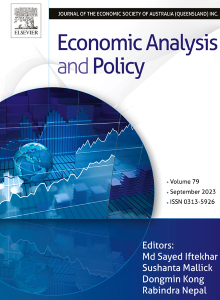Digital transformation and corporate green total factor productivity: Based on double/debiased machine learning robustness estimation
IF 7.9
2区 经济学
Q1 ECONOMICS
引用次数: 0
Abstract
With the rapid development of the digital economy, China's digital technology and industry continue to integrate deeply into all areas of society. Digital transformation(DT) has become an important engine and key pedestal for economic and social transformations and upgrades. This paper takes 3525 listed companies from 2013 to 2021 as a sample to measure the green total factor productivity(GTFP) of listed enterprises based on the super-efficiency slacks-based measure with the Global Malmquist-Luenberger Index (SBM-GML) and the super-efficiency epsilon-based measure with the Global Malmquist-Luenberger Index (EBM-GML). It draws on the two existing DT indicators to explore the impact and mechanism of enterprise DT on GTFP. The results show that DT can significantly enhance GTFP, and this conclusion still holds after double/debiased machine learning and other robustness tests; the heterogeneity analysis shows that DT of high-tech enterprises, manufacturing industries and low-financialisation enterprises has a more obvious effect on the enhancement of GTFP; and the four-stage mediated impact mechanism suggests that the effect of DT on GTFP can be achieved by improving internal control ability and technological innovation ability. This paper will provide relevant policy insights on how to better drive enterprise DT and green low-carbon development under the “dual-carbon” goal.
数字化转型与企业绿色全要素生产率:基于双重/偏差机器学习的稳健性估计
随着数字经济的快速发展,中国的数字技术和产业不断深入社会各个领域。数字化转型(DT)已成为经济社会转型升级的重要引擎和关键基石。本文以2013-2021年的3525家上市公司为样本,基于全球马尔奎斯特-伦伯格指数(SBM-GML)的超效率松弛指标和全球马尔奎斯特-伦伯格指数(EBM-GML)的超效率ε指标,测度上市企业的绿色全要素生产率(GTFP)。研究借鉴了这两个现有的 DT 指标,探讨了企业 DT 对 GTFP 的影响和作用机制。结果表明,DT能显著提升GTFP,且该结论在经过双重/偏差机器学习等稳健性检验后仍然成立;异质性分析表明,高新技术企业、制造业和低财务化企业的DT对GTFP的提升效果更为明显;四阶段中介影响机制表明,DT对GTFP的影响可以通过提高内部控制能力和技术创新能力来实现。本文将为 "双碳 "目标下如何更好地推动企业 DT 和绿色低碳发展提供相关政策启示。
本文章由计算机程序翻译,如有差异,请以英文原文为准。
求助全文
约1分钟内获得全文
求助全文
来源期刊

Economic Analysis and Policy
ECONOMICS-
CiteScore
9.80
自引率
9.20%
发文量
231
审稿时长
93 days
期刊介绍:
Economic Analysis and Policy (established 1970) publishes articles from all branches of economics with a particular focus on research, theoretical and applied, which has strong policy relevance. The journal also publishes survey articles and empirical replications on key policy issues. Authors are expected to highlight the main insights in a non-technical introduction and in the conclusion.
 求助内容:
求助内容: 应助结果提醒方式:
应助结果提醒方式:


